Abstract
The aging behavior of microplastics (MPs) in the environment has garnered significant attention, yet the exact aging process undergone by microplastics during advanced oxidation still remains unclear. This study emphasized elucidating the oxidation and dechlorination mechanisms of polyvinyl chloride microplastics (PVC MPs) within the UV-activated sodium percarbonate system (UV/SPC). After 35 h of UV/SPC (0.05 M) treatment, it exhibited effective dechlorination with a Cl− release of 100.62 ± 13.17 mg/L. And this treatment resulted in the fragmentation and release of fragments from the PVC MPs, thereby contributing to their further aging and dechlorination. In addition, an increase in oxygen-containing functional groups was identified. Quenching experiments confirm that and are the primary active species present in the system. In summary, the aging of PVC MPs results in a process of fragmentation, releasing fragments that are more fragile and susceptible to mineralization compared to the original PVC MPs. The release of chloride ions originates from the mineralization of these fragments released from PVC MPs by and . This study has provided valuable insights into the aging mechanisms of MPs in practical wastewater treatment.
1. Introduction
Over the past 50 years, global plastics production has skyrocketed, increasing from 1.7 million tons in 1950 to 335 million tons in 2016, a near-two-hundred-fold jump [1]. This rampant growth, however, has come with a cost: the fragmentation of discarded plastics in the environment results in the release of microplastics, varying in size from the nanometer scale up to 5 mm [2]. Microplastics are widely distributed and of various types detected in diverse environments, encompassing soil [3], oceans [4], rivers [5], bottled water [6], sediments [7], urban wastewater [8], and even the air we breathe [9]. Microplastics, which can adsorb harmful substances [10,11,12] and are toxic to organisms [13], have been found in various biological bodies [14,15,16], including humans [17]. Among these microplastics, polyvinyl chloride (PVC) stands out as one of the most commonly encountered types [18,19,20]. The aging of microplastics is divided into two categories: natural aging and artificial aging. Since the natural aging process of microplastics often takes an exceptionally long time, the artificial aging of microplastics has garnered considerable attention from scholars [21]. The aging of microplastics leads to changes in their surface properties, such as specific surface area [22,23] as well as in their physical characteristics, including crystallinity [24], ultimately affecting their behavior within the environment [25,26]. In the methods of artificial aging, advanced oxidation techniques (AOPs) excel due to their stability and performance across diverse conditions, coupled with lower operational complexities and costs compared to other methods [27].
Among the various radicals generated by advanced oxidation, hydroxyl radicals have proven effective in degrading microplastics [28]. Fenton oxidation, a classic technique utilizing hydroxyl radicals to remove pollutants, faces challenges due to the strict transportation and storage requirements of , resulting in high supply costs and limiting its practical application in wastewater treatment [29]. Sodium percarbonate (, SPC), known as solid hydrogen peroxide, has emerged as an ideal alternative due to its stability, low cost, convenience and safety to transport [30]. SPC can also be activated by transition metals like Fe(II)/Fe(III) to achieve a Fenton-like reaction in water treatment [31], but the presence of metal ions relies on acidic pH, leading to secondary contamination from metal precipitates [32]. However, UV-activated SPC (UV/SPC) has no such limitations. UV/SPC has been applied for the removal of a variety of pollutants, including aniline [33], natural organic matter (NOM) [34], tetracycline (TC) [35], and bisphenol A (BPA) [36], demonstrating significant potential for application in water treatment.
Since is an adduct formed by the connection of and through hydrogen bonds, it easily decomposes and releases and when dissolved in water [37]. The generation of radicals in the UV/SPC system can be divided into two aspects: (1) the production of by the decomposition of SPC releasing under UV irradiation; and (2) the reaction of with coexisting and to produce . As shown in Equations (1)–(4), the production of consumes , the redox potential of (2.32 V vs. SHE at pH 7) is higher than that of (1.78 V vs. SHE at pH 7) [36], so the presence of and reduces the efficiency in degrading some pollutants such as aniline [33]. The presence of , however, allows the degradation efficiency of certain pollutants to remain unchanged or even be enhanced, such as BPA and TC [35,36]. Gao et al. concluded that contributes significantly to the degradation and transformation of electron-rich organic pollutants, which can react with electron-rich compounds by electron transfer or hydrogen extraction [36]. Furthermore, the high steady-state concentration of can offset its limited reactivity towards target reactants and the consumption of [30], potentially enhancing the degradation rate of pollutants. In conclusion, has the potential to efficiently degrade organic pollutants. However, to date, there have been few studies investigating the mechanism of how microplastics (MPs) undergo aging under UV/SPC conditions.
In this study, PVC was selected as the target MPs because its aging process releases chloride ions [38], providing a more intuitive demonstration of the aging extent. The main objectives of this study are as follows: (1) to investigate the dechlorination and morphological changes in PVC MPs during the reaction process; (2) to explore the active species that play a major role in the aging of PVC MPs; (3) to delve into the aging mechanism of PVC MPs in UV/SPC, and (4) to assess the aging effect of PVC MPs under UV/SPC treatment in practical wastewater treatment.
2. Materials and Methods
2.1. Materials
PVC MPs were purchased from Aladdin Co., Ltd. (Shanghai, China). Sodium percarbonate (, 13–14% active oxygen) was purchased from Macklin Co., Ltd. (Shanghai, China). Hydrogen peroxide (, ≥30%) was purchased from Kelong Co., Ltd. (Chengdu, China). Detailed information on PVC and handling before use is shown in Text S1. Other chemicals used in the experiment were included in Text S2.
2.2. Experimental Procedures
A low-pressure mercury lamp (with a primary emission wavelength of 254 nm, 10 W) was used as the irradiation source for the photoresponse experiments. A 200 mL aqueous solution, 0.5 g of PVC and the required amount of SPC were filled in a 250 mL tall beaker and irradiated. The beaker was wrapped in tinfoil to prevent UV from escaping. The system was set in a thermostatic water bath at 30 °C with sufficient agitation so that the PVC and SPC were evenly dispersed in the solution. Samples were withdrawn at specified intervals. The samples to be measured were filtered through a 0.45 μm membrane and the concentration of Cl− released from PVC was subsequently measured by IC (IC, Dionex AQ-1100, Thermo Fisher Scientific, Waltham, MA, USA). Before testing, the treated PVC needed to be freeze-dried. All experimental procedures were standardized to ensure the accuracy of the results, including the effects of different SPC dosages and the control experiments using only SPC or UV. Error analysis was carried out in all experiments.
2.3. Analytical Methods
2.3.1. Characterization Methods
The Fourier Transform Infrared Spectrometer (FTIR, Nicolet 6700, Thermo Fisher Scientific, MA, USA) is utilized to analyze the functional group composition and changes in PVC MPs before and after reactions, with a detection wavelength ranging from 400 to 4000 cm−1. A Scanning Electron Microscope (SEM, JSM-7500F, JEOL, Tokyo, Janpan) is employed to investigate the surface morphological changes in the PVC MPs. Prior to analysis, the PVC MPs are coated with a conductive layer to enhance their surface conductivity and then scanned in secondary electron mode with an appropriate resolution of 5 μm at 5.0 KV. An X-ray diffractometer (XRD, EMPYREAN, PANalytical B.V., The Netherlands) is used to study the crystallinity changes in PVC MPs before and after reactions. The crystal structure images of the PVC MPs are obtained using the Cu target kα radiation mode. The scanning range is set from 5 to 60°, with a step size of 0.025°, and the scanning mode is set to continuous. An X-ray photoelectron spectrometer (XPS, ESCALAB 250Xi, Thermo Fisher Scientific, MA, USA) is employed to characterize the surface elemental content changes in PVC MPs before and after reactions. The full-spectrum power is set at 15 kV, 5 mA, while the sub-spectrum power is 15 kV, 10 mA. All spectra are calibrated using C 1s = 284.6 eV. The specific surface area of the PVC MPs is determined using a rapid surface area and pore size analyzer (ASAP2020, Micromeritics, Shanghai, China), employing the Brunauer–Emmett–Teller (BET) method. The final degassing temperature is set at 50 °C, and the ultimate vacuum value is 50 μm Hg. Gas chromatography-mass spectrometry (GC-MS, TSQ9000, Thermo Fisher Scientific, MA, USA) was used to detect the reaction by-products, and the filtered reaction solution was first subjected to solid phase extraction before detection.
2.3.2. Release of Chloride Ions
The Ritger and Peppas model is employed to investigate the release mechanism of Cl− and fit the release curve:
Generally, where and are the amount of Cl− released at time t and equilibrium, respectively, k is the release rate constant, and n is the release index indicating the nature of the release mechanism. In this study, represents the release of Cl− at the end (35 h) of the reaction.
The Ritger and Peppas model was originally used to describe diffusion mechanisms [39] and now mostly used to describe drug release mechanisms. Due to the special skeleton structure of PVC microplastics and the different forms of dechlorination and release in the UV/SPC system, which were similar to certain photosensitizing drug carriers for drug release. Therefore, the Ritger and Peppas model was used to describe the mechanism of Cl− release from PVC MPs in the photocatalytic system.
When n < 0.45, the chloride ion release mechanism is Fick diffusion, when 0.45 < n < 0.89, the chloride ion release mechanism is non-Fick diffusion and when n > 0.89, the chloride ion release mechanism is skeleton erosion [40]. The detailed meaning is mentioned later.
2.3.3. Carbonyl Index
The FTIR spectra obtained for PVC MPs samples were used to estimate the Carbonyl Index (CI), since the FTIR technique allows for the measurement of several by-products containing carbonyl functional groups formed on the particle surface as a result of the oxidation of the material [41]. The CI is determined by calculating the ratio of the carbonyl peak to the reference peak [42]. Therefore, this work used CI as a measure of PVC oxidation, which enabled the quantification of several modifications to the material’s chemical structure. The PVC MPs selected in this study were easily identified as having a newly generated absorption peak at wave number 1710–1730 cm−1 after processing, The intensity levels observed varied depending on the aging process and exposure time as a result of the C=O stretching of the carbonyl group generated by the reaction, which carries a strong and characteristic infrared absorption peak at 1715 cm−1 [43].
According to Mariana et al.’s statistics [41], there is no universal method for calculating CI. Some researchers have chosen to calculate the CI as the ratio of the absorption areas of the two peaks or the maximum absorption heights of the two peaks. In addition, the selection of reference peaks for each microplastic varied in different studies, and researchers also used different methods based on the transmittance or absorbance patterns of the FTIR spectra. In our study, the FTIR measurements were performed in transmission mode, and the maximum height of the selected peaks was transformed from transmittance (T) to absorbance (A) by Equation (6). After screening various peaks as reference peaks, we selected the peak formed by the symmetric stretching vibration of the methylene (-CH2-) group, which exhibited little variation under all the different system treatments mentioned in this study, as the reference peak for PVC MPs. The CI was calculated as shown in Equation (7).
3. Results and Discussion
3.1. The Dechlorination of PVC
To explore the aging effect of PVC MPs in UV/SPC systems and to validate the synergistic effects of UV and SPC, we conducted a controlled variable study, investigating the dechlorination effects of PVC in systems where UV or SPC was applied individually. As shown in Figure 1a, the release of Cl− from PVC MPs in the system with SPC alone proceeded at a slow pace throughout the entire treatment process. After 35 h of treatment, the concentration of Cl− released into the solution was 15.16 ± 1.81 mg/L. The Cl− release from PVC MPs in the system with UV irradiation alone reached 54.05 ± 0.52 mg/L. This finding is consistent with the research conducted by Ouyang et al., who demonstrated that UV can age PVC MPs in water and promote the release of Cl− [44]. After the same treatment time, the chlorine release in the UV/SPC system reached 100.62 ± 13.17 mg/L, which was 1.86 times higher than that in the UV-alone system, highlighting the synergistic effect of combining UV with SPC. The enhanced dechlorination effect can be attributed to the oxidative radicals, such as and generated by the activation of SPC by UV (Equations (1)–(4)). These oxidative radicals effectively oxidize and age microplastics [30], and Cl− is released during this process [38]. The dechlorination ability of other photocatalytic, biodegradation and hydrothermal carbonization (HTC) technologies for PVC MPs was summarized as shown in Table S1, and it can be concluded that the dechlorination ability of UV/SPC is higher than that of UV/PS [44] and photocatalytic LMWOA-Fe(III) [38]. Biodegradation is inherently different from advanced oxidation technology in terms of degradation efficiency [45], while HTC has a good dechlorination efficiency in a shorter period of time but consumes additional energy [46].
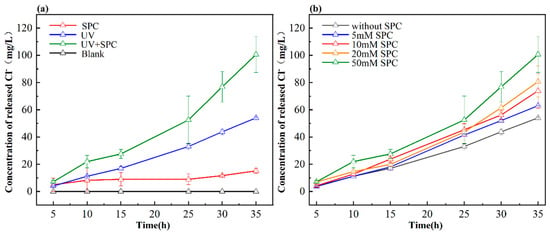
Figure 1.
The concentration of released Cl− in PVC MPs is compared between (a) UV and SPC and (b) Different concentrations of SPC and UV only. Conditions: [PVC] = 2.5 g/L.
In addition, experiments were conducted to investigate the initial dosage of SPC. In the UV/SPC system, SPC is irradiated by UV to produce a large number of oxidative radicals. Therefore, the initial dosage is an important factor that affects the aging and dechlorination of PVC MPs, necessitating further investigation. As shown in Figure 1b, the dechlorination effect of PVC MPs increases with an increase in the initial dosage of SPC. However, SPC contains a small amount of NaCl impurities, and the chlorine ions released from NaCl can interfere with the measurements, leading to increased errors. The larger the initial dosage of SPC, the greater the error. Therefore, the dosage of SPC was limited to 0.05 M. With the increase in initial SPC concentration (0.005–0.05 M), the release of chlorine ions from PVC rapidly rose from 63.00 ± 0.26 mg/L to 100.62 ± 13.17 mg/L under UV irradiation for 35 h. As evident from the graph, the dechlorination rate was not constant, it accelerated as the treatment time progressed. Additionally, the timing of this acceleration varied across systems with different initial concentrations. Specifically, a significant inflection point was observed at 15 h for the system with an initial concentration of 0.005 M, while the inflection point occurred at 25 h for the 0.05 M system. This phenomenon could be attributed to the self-quenching of high concentrations of radicals. When SPC dissolves in water, it generates a significant amount of and . At high concentrations, these reactive species compete with pollutants for reactions (Equations (8) and (9)) [36], thereby affecting the efficiency of oxidation and dechlorination. In conclusion, the dechlorination of PVC MPs increased with the initial SPC dosage in the range of 0–0.05 M dosage.
The Ritger Peppas model was used to fit the nonlinearities of the UV alone and UV/SPC systems, and the fitting results are shown in Figure S1. Based on the analysis of the fitted data, the UV and UV/SPC models both presented patterns of skeleton erosion, which means the destruction of the PVC MPs’ structure and carbon chain, a phenomenon that occurs during the oxidation of MPs [30]. However, oxidizing radicals are weakly dechlorinating [47], and the release of Cl− is often accompanied by a high degree of oxidation, suggesting that Cl− are released during the mineralization of PVC MPs by oxidizing radicals. This result may also explain the accelerated release of Cl− in the UV/SPC system. Oxidation is a cumulative process, and researchers have found that MPs produce fragile intermediate products that detach from their skeletons during oxidation [48]. The fragile intermediate is derived from the main chain breakage of PVC MPs, which are essentially oxidized chlorinated hydrocarbons. Because they are fragile, they are more susceptible to mineralization and Cl− is released during this process. With increasing treatment time, shedding intermediates were accumulated, so the rate of Cl− release became faster.
3.2. Morphology Characterization of PVC
3.2.1. Morphologies
SEM was used to observe the change in surface morphology of PVC MPs before and after treatment. Figure 2a shows the initial sample without UV/SPC treatment, and it can be observed that the surface is relatively intact and dense with only some small pits. And as shown in a–f, after 35 h of UV/SPC treatment with different initial dosages, varying sizes of holes or cracks appeared on the surfaces, which would expose the interior of PVC MPs to the attack of free radicals and favor further aging. UV easily induces photochemical reactions in the chromophores of PVC MPs [49] and causes particle surface aging [50]. While UV aging of PVC MPs accelerates the aging process in the presence of oxidants, Dong et al. showed that direct photolysis of UV dominated microplastics at low concentrations of oxidants or in the early stages of aging and that as the concentration of oxidants increased or as the degree of aging increased, indirect photolysis gradually dominated [51]. From the SEM images, it can be clearly observed that when the initial SPC dosage was 50 mM, the surface of PVC MPs was severely damaged and the internal structure was completely exposed, which indicates that UV/SPC can effectively age PVC MPs. In addition, it can be observed that the surface of the treated PVC MPs has generated some fragments that seem to be ready to peel off at any time, and it can be assumed that it is the peeling of these fragments that causes holes or cracks to appear on the surface. As the fragments gradually peel off, the holes or cracks expand in size, until the internal structure is completely exposed, thus resulting in a new round of peeling. As mentioned earlier, these flaked fragments continue to be attacked by radicals, and in the process, chloride ions are released. It is worth noting that after the addition of a sufficient amount of PhOH to quench the major radicals in the system, the surface of PVC MPs was still damaged, and the extent of the damage was similar to that of the initial dosage of 5 mM, which may be caused by the presence of other minor active species in the system, like or the direct photolysis by UV. Due to its low redox potential (), which contributes less to the direct degradation of the target pollutant, is often ignored [52]. However, when the main active substance in the system is quenched, the role of may be revealed.
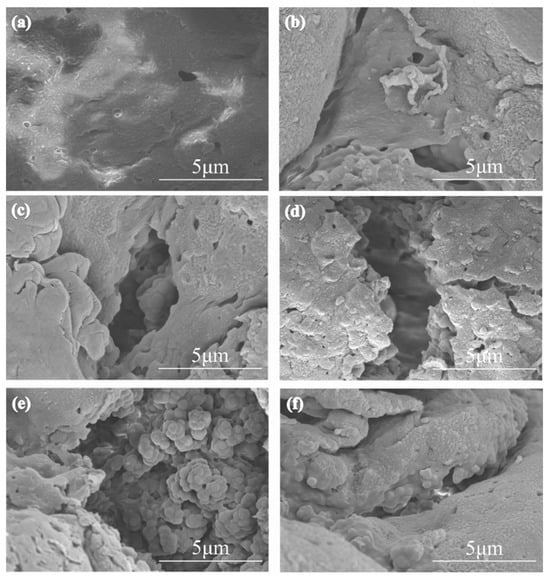
Figure 2.
SEM of (a) pristine and (b–f) treated PVC MPs. (b–e) 5 mM, 10 mM, 20 mM and 50 mM SPC with UV, (f) 50 mM SPC + 50 mM PhOH with UV.
The appearance of surface holes and cracks is often accompanied by an increase in the specific surface area, and for the further study of the morphological changes in PVC MPs, the Brunauer–Emmett–Teller (BET) method was used to characterize the changes in the specific surface area before and after the treatment. Specific data are shown in Table S2. The specific surface area of the treated PVC MPs is 1.68 times higher than that before the treatment, and there is also a substantial increase in the specific surface area after quenching experiments, which supports the above conjecture.
To further investigate the microstructural changes in PVC MPs before and after the treatment, XRD was used to analyze the changes in crystallinity (Figure 3). Ouyang et al. found that two peaks appear between 10° and 30° for PVC MPs, and the peaks become sharp, probably due to the change in the structure of PVC MPs itself and the destruction of C-Cl bonds, as the crystallinity of PVC MPs increases [44]. In agreement with the research, it can be observed that the peak near 20° becomes sharp after UV/SPC treatment. In addition, the increase in crystallinity means that the plastic becomes more fragile and thus more prone to producing smaller particles [53], which coincides with the appearance of fragments on the surface of the treated PVC MPs observed in the SEM images.
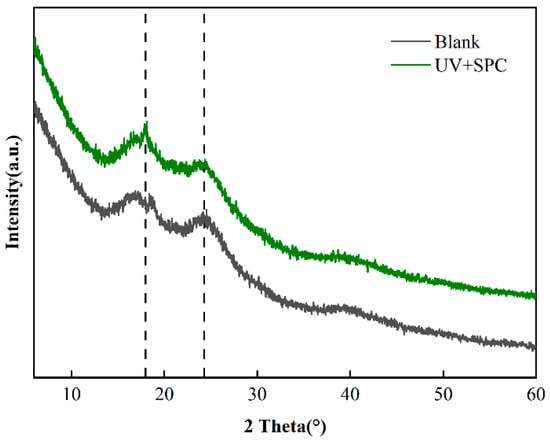
Figure 3.
XRD image of PVC MPs before and after PVC MPs treatment. Conditions: [PVC] = 2.5 g/L, [SPC] = 50 mM.
3.2.2. Functional Groups
In order to explore the oxidation mechanism and further investigate the dechlorination mechanism of PVC MPs in the UV/SPC system, the functional groups on the surface of PVC MPs were analyzed by FTIR. As shown in Figure 4a, there are two characteristic peaks associated with chlorine on the infrared spectrum of PVC MPs, which appear at 605 cm−1 and 1250 cm−1, respectively, and they are generated by the stretching vibrations of the C-Cl group and the CH-Cl group [44,54]. Another characteristic peak appearing at 2909 cm−1 represents the stretching vibrational signal of methylene (-CH2) [54]. A new characteristic peak at 1715 cm−1 emerged on the spectrum of UV/SPC-treated PVC MPs, attributable to the stretching vibration of the C=O group [43], and the corresponding carbonyl index in Figure 4b demonstrates a significant increase for all treated PVC MPs, indicating that the active species present in the system can oxidize PVC MPs. It can be clearly observed that the signal intensity belonging to the C=O group is the strongest when the initial SPC dosage is 50 mM, and the concentration of chloride ions released from PVC MPs is also the highest at the same condition, which suggests that there exists a relationship between the concentration of released Cl− and the degree of oxidation. However, the characteristic peak signals of CH-Cl and C-Cl groups related to chlorine both showed different degrees of enhancement after treatment, which may be related to the inability of oxidizing radicals to attack the C-Cl bond directly. Evidence for this speculation is the very low contribution of oxidizing radicals to dechlorination found by Miao et al., who found 1% dechlorination of PVC MPs in an anode chamber where only oxidizing radicals were present (8–10% in a cathode chamber) [47]. The enhanced signals representing chlorine are due to the increased specific surface area of the treated PVC MPs, resulting in more chlorine-containing groups being detected. In conclusion, the enhancement of the signals at 1250 cm−1 and 605 cm−1 illustrates the inability of oxidizing radicals to release Cl− by selectively breaking the C-Cl bond.
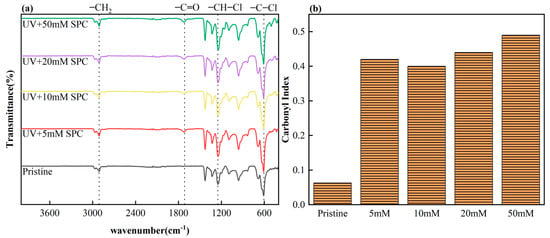
Figure 4.
(a) The FTIR spectra and (b) CI values of pristine and treated PVC MPs with different SPC initial dosages.
3.2.3. Chemical Composition and Intermediates of PVC
As shown in Figure 5, the XPS analysis exhibits the changes in surface elemental content and functional groups before and after the treatment of PVC MPs. Figure 5a shows the XPS total spectrum; the total amount of carbon on the surface of PVC MPs after UV/SPC treatment decreased. Combined with Figure 2e, it can be concluded that the main reason is that the MPs surface was severely damaged by UV/SPC at the initial dosage of 50 mM to form oversized voids and lose a large number of carbon chains, which was also seen in other studies [30]. And there may be two reasons for the decrease in total oxygen content: the first is also because the surface of PVC MPs is severely damaged to expose the internal surface that has not yet been oxidized, and the second is that on the surface of PVC MPs in the oxidation process, there will be a lot of fragments containing oxidation intermediates flaking, and these fragments of flaking take away part of the oxygen element. The high amount of oxygen on the surface of the initial PVC MPs may indicate that PVC is also easily oxidized in the environment. A similar observation has been made in other studies, where the oxygen content of untreated PVC reached 10.42% [44]. But in combination with Figure 2a, it can be found that the slight degree of oxidization remains only on the surface. In addition, the fluorine that appeared on the surface after the treatment came from the PTFE stirrer, and it is possible that the surface of the stirrer was broken, resulting in debris mixing into the PVC MPs sample.
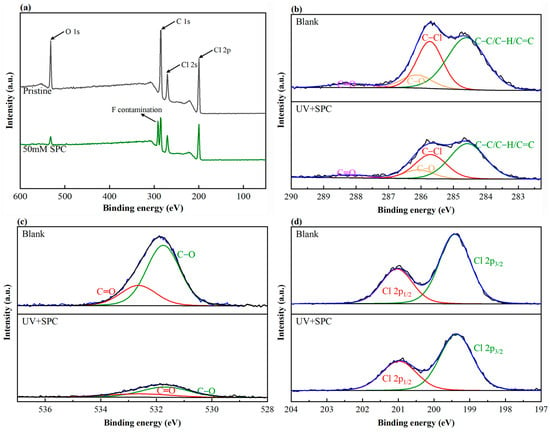
Figure 5.
(a) XPS total spectrum (b) C 1s spectrum (c) O 1s spectrum (d) Cl 2p spectrum of original and aging PVC MPs. Conditions: [PVC] = 2.5 g/L, [SPC] = 50 mM.
As shown in Figure 5b, the XPS spectrum of C 1s is divided into four peaks, including C=C/C-C/C-H, C-Cl, C-O, and C=O, with binding energies centered at 284.6, 285.7, 286.1, and 288.2 eV, respectively [55,56]. The specific proportion of each peak is shown in Table S3, which shows that the proportion of the peaks representing C-Cl after treatment did not change significantly, which further indicates that the active species within the UV/SPC system cannot directly break the C-Cl bond to release Cl−. As shown in Figure 5c, the XPS spectrum of O 1s is divided into two peaks, including C=O (532.6 eV) and C-O (531.7 eV) [55], and the percentage of the C=O peak is slightly increased after the treatment, but it is not much different from the original PVC MPs, for reasons that are consistent with the total spectrum. In addition, the XPS spectrum of Cl 2p (Figure 5d) is decomposed into two peaks at 201.0 and 199.4 eV [55], which belong to Cl 2p1/2 and Cl 2p3/2, respectively. The reason for the decrease in the total amount of chlorine after the treatment is in line with the reason for the decrease in the total amount of carbon.
In addition, the filter solution of UV/SPC-treated PVC MPs was analyzed by GC-MS. As shown in Table S4, seven major products were detected, including ketone and ester organics. These products originate from oxidative processes with oxygenated functional groups (-C=O, -COO). They detach from the surface of the MPs and exist in solution, which corresponds to taking away the elemental oxygen from the surface, which is consistent with the XPS total spectrum.
3.3. Oxidation and Dechlorination Mechanism of UV/SPC System for PVC MPs
3.3.1. Reactive Species Contribution to Dechlorination
According to the relevant studies, the main reactive species present in the UV/SPC system are and [30,36,57], and in order to further determine the contribution of the different radicals for dechlorination, ethanol (EtOH) was used for ∙OH scavenging (), and phenol (PhOH) was used for quenching of and (, ) [36]. As shown in Figure 6, the addition of 75 mM EtOH resulted in a 38.47% decrease in chloride release from 100.62 ± 13.17 mg/L to 61.91 ± 15.23 mg/L in the UV/SPC system. The addition of 50 mM PhOH led to a 93.10% decrease in chloride release to 6.94 ± 0.51 mg/L, indicating that and are the main active species in this system. From the results of the quenching experiments, it can be concluded that the contribution of to the dechlorination of PVC MPs in the UV/SPC systems is greater than that of . However, this result does not mean that the dechlorination capacity of is higher than that of , because the generation of consumes part of (Equations (2)–(4)). The formation of in the UV/SPC system occurs in two ways. The first one is to consume directly to produce the same amount of (Equation (2)), and the second one is to react with H2O2 to form an intermediate, and the intermediate will continue to produce the same amount of and (Equations (3) and (4)), and the original H2O2 activated by the UV can produce twice the amount of as its own (Equation (1)), so the production of can be theoretically regarded as the consumption of the same amount of .
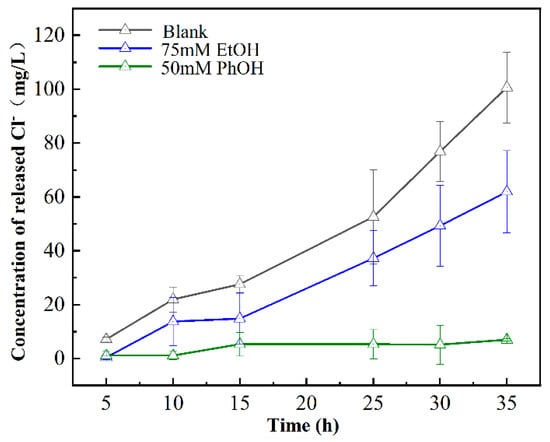
Figure 6.
Concentration of released Cl− of PVC MPs in quenching experiment. Conditions: [PVC] = 2.5 g/L, [SPC] = 50 mM.
In order to further investigate the dechlorination ability of and , experiments with H2O2 and Na2CO3 instead of SPC were designed, and the results of the experiments are shown in Figure 7a. According to the experimental results, the releases of Cl− in the two systems of UV/H2O2 and UV/H2O2/Na2CO3 were 72.86 ± 18.85 mg/L and 75.60 ± 2.07 mg/L, respectively, with almost no difference, which indicated that the dechlorination ability of the active species in the two systems was not much different, and the main active species in the UV/H2O2 system was , while both and existed in the UV/H2O2/Na2CO3 system. However, was generated by consuming an equal amount of in the UV/H2O2/Na2CO3 system, but the fitted reaction rate constants a, release constants n, and the Ritger and Peppas model curves were similar (Figure 7b), which proved that the dechlorination ability of and was comparable for PVC MPs. While both UV/H2O2 and UV/H2O2/Na2CO3 systems were not as effective as the UV/SPC system for dechlorination, this could be due to the excessive initial dosage of oxidant leading to the self-quenching of and (Equations (8) and (9)) [36]. However, the H2O2 in SPC is required to be produced by SPC decomposition, which may contribute to the slow release of H2O2, especially advantageous in degrading PVC MPs, which is a long-term treatment process.
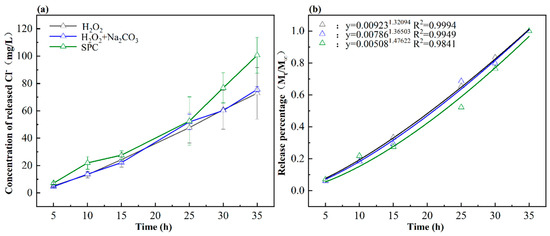
Figure 7.
(a) comparison of chloride ion concentration released by PVC MPs in different UV excitation systems (b) Ritger and Peppas model fitting. Conditions: [PVC] = 2.5 g/L, [SPC] = 50 mM, [H2O2] = 33.75 mM, and [Na2CO3] = 50 mM.
This discovery holds significant value for the application of the UV/SPC system in the aging of PVC MPs, as the removal efficiency of does not always reach the same level as that of for all pollutants. For instance, when degrading aniline [33], the reaction rate constant of the UV/H2O2 system is nearly twice as high as that of the UV/SPC system. However, some pollutants, showed a notable oxidizing ability. For example, in the study of treating TC, the removal efficiency of the UV/SPC system reached 89.1% under the same treatment conditions, while the removal efficiency of UV/H2O2 for TC was only 45.1%, which was significantly lower than that of the UV/SPC system [35]. When removing BPA, the removal efficiency of UV/H2O2, UV/SPC and UV/H2O2/Na2CO3 for BPA was basically the same under the same conditions [36]. In the removal of PS MPs, quenching experiments revealed that plays a primary role while plays a secondary role [30]. However, unlike PVC MPs, TC, BPA, and PS MPs all have a benzene ring and are electron-donating groups with the benzene ring, making them electron-rich pollutants, which is consistent with the electrophilic nature of . The high capacity exhibited by for PVC MPs aging can be attributed to the higher steady-state concentration of compared to , which needs to be further explored.
In addition, in a study that also investigated the aging of PVC MPs by UV-catalyzed oxidants [4], the dechlorination efficiency of UV/PS for PVC MPs was lower than that of ours, and the major radicals in their system were and , whereas the major radicals in our system, UV/SPC, were and , which indicates that has better performance for PVC dechlorination than .
3.3.2. Reactive Species Contribution to Oxidation
To further investigate the ability of and to oxidize PVC MPs, samples of PVC MPs treated by quenching experiments were taken to analyze the functional groups by FTIR. As shown in Figure 8a, observing the C=O group representing the degree of oxidation in the FTIR band, it was found that the intensity of the peak at 1715 cm−1 of the PVC MPs samples produced by the UV/SPC system with the addition of PhOH did not change significantly, while the intensity with the addition of EtOH increased significantly, this indicates that the quenching of and by PhOH completely inhibited the generation of oxidizing groups on the surface of PVC MPs, which means the oxidation by the UV/SPC system was inhibited, whereas the quenching of by EtOH still generated some oxidizing groups on the surface of PVC MPs, which proves that even though ∙OH was quenched, was still able to oxidize the PVC MPs in the UV/SPC system. Combined with Figure 8b, the CI of PVC MPs samples produced by the UV/SPC system with the addition of EtOH is 0.42, and the CI value of the UV/SPC system is 0.49, which suggests that the can oxidize the PVC MPs efficiently and plays a major role in the UV/SPC system.
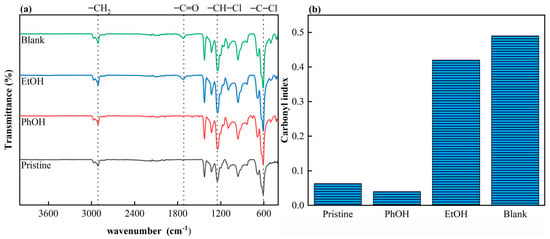
Figure 8.
(a) FTIR spectrum and (b) CI value of PVC MPs before and after quenching treatment. Conditions: [PVC] = 2.5 g/L, [SPC] = 50 mM, [EtOH] = 75 mM, [PhOH] = 50 mM.
However, the FTIR spectra of the PVC MPs samples produced by the UV/SPC system with PhOH showed the same characteristics as the other oxidized PVC MPs samples, which means the intensity of the peak representing the CH-Cl group at 1250 cm−1 was significantly enhanced compared to the pristine PVC MPs sample. This is also caused by the increased specific surface area (Table S2). In addition, the reason for the decreased CI value may be due to the previously mentioned , because it is not an oxidizing radical, it breaks the chain on the microplastic surface, taking some of the oxygen with it. This explains both the surface destruction and aging (Figure 2f and Table S2) of the microplastics and why the CI decreases instead. Although the surface of PVC MPs had been damaged and the specific surface area increased accordingly, only 6.94 ± 0.51 mg/L of Cl− were released, suggesting that the dechlorination was asynchronous with the oxidation of PVC MPs and that dechlorination was accompanied by a higher degree of aging.
3.3.3. Oxidation and Dechlorination Mechanism of PVC MPs in UV/SPC
Based on the dechlorination effect, the characterization results and the radical quenching experiments, the oxidation and dechlorination mechanisms of PVC MPs in the UV/SPC system were proposed. Dechlorination and oxidation of PVC MPs do not occur together; in the early stages of oxidation, direct photolysis and and from UV/SPC oxidize PVC MPs, generating oxidation intermediates (fragments) that can be detached from the polyvinyl chloride surface. These intermediates are formed when active species break down the chains on the surface of PVC MPs, whose chains originally contained a large amount of chlorine. With the increase in reaction time, the oxidation intermediates are gradually mineralized; in this process, the Cl− are released and in the whole process, the main role is played by , and plays an auxiliary role.
3.4. Application of UV/SPC in Actual Water Bodies
The aging performance of UV/SPC for PVC MPs in two real water bodies was investigated. The river water samples were taken from Jiangan River (River J, Chengdu, China), and the secondary effluent of the sewage plant (SE) was taken from a sewage treatment plant in Shuangliu (Chengdu, China). The indicators of the two actual water bodies are shown in Table 1. As shown in Figure 9, the dechlorination effect of PVC MPs was inhibited in both actual water bodies. Similarly, when Gao et al. applied UV/SPC for BPA removal in secondary effluent from a wastewater plant, the same inhibition was observed. The explanation was due to the scavenging effect of complexes contained in the effluent, which led to a significant reduction in the concentration of radicals and turbidity, thereby decreasing the UV transmittance [36]. Additionally, it is also possible that coexisting anions and organic pollutants in the water body are competing with the PVC MPs for the reaction, depleting and subsequently hampering the generation of [58]. Thus, it seems that UC/SPC may be more suitable for the treatment of reuse water [36]. Currently, there are scant reports on advanced oxidation techniques effectively removing microplastics from actual water bodies, a domain that deserves further exploration and research.

Table 1.
Various indicators of actual water bodies.
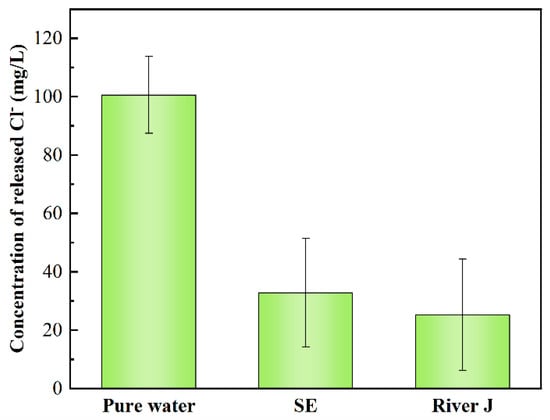
Figure 9.
Dechlorination effect of PVC MPs in different water qualities. Conditions: [PVC] = 2.5 g/L, [SPC] = 50 mM.
4. Conclusions
In this study, the aging and dechlorination mechanisms of PVC MPs in UV/SPC were investigated. The aging and dechlorination of PVC MPs increased with the increase in SPC dosage when the initial dosage of SPC was 0.005–0.05 M and the maximum chloride release concentration was 100.62 ± 13.17 mg/L in 35 h. The characterization results revealed that the surface of treated PVC MPs exhibited fragments, and the peeling off of the fragments resulted in the formation of cracks and holes, accompanied by an augmentation in the specific surface area. This confirmed that the aging of PVC MPs involved a fragmentation process, releasing fragile fragments that were more susceptible to mineralization compared to the original PVC MPs. And the release of chloride originates from the mineralization of fragments by and . Additionally, this study has provided valuable insights into the aging mechanisms of MPs in practical wastewater treatment, yet further research is still needed to deepen our understanding, such as by experimenting with a wider range of MPs samples.
Supplementary Materials
The following supporting information can be downloaded at: https://www.mdpi.com/article/10.3390/w16111529/s1, Text S1: The information of PVC. Text S2: Materials and reagents. Figure S1: Release kinetic model of PVC MPs in each system. A: only UV; B: UV+5 mM SPC; C: UV+10 mM SPC; D: UV+20 mM SPC; C: UV+50 mM SPC Conditions: [PVC] = 2.5 g/L. Table S1: Comparison of dechlorination efficiency of various PVC MPs aging technologies. Table S2: Specific surface area of PVC MPs before and after reaction. Table S3: The area proportion of each peak in the XPS spectrum. Table S4: The major products of PVC MPs under UV-activated SPC treatment.
Author Contributions
Conceptualization, Z.L., Y.W. and Q.W.; Methodology, L.S.; Investigation, L.S.; Resources, Z.L., Y.W. and Q.W.; Data curation, J.H. and L.S.; Writing—original draft, L.S.; Supervision, Q.W.; Funding acquisition, Q.W. All authors have read and agreed to the published version of the manuscript.
Funding
This research was funded by Fundamental Research Funds for the Central Universities.
Data Availability Statement
Data are contained within the article and Supplementary Materials.
Conflicts of Interest
The authors declare no conflict of interest.
References
- Ali, N.; Khan, M.H.; Ali, M.; Sidra; Ahmad, S.; Khan, A.; Nabi, G.; Ali, F.; Bououdina, M.; Kyzas, G.Z. Insight into microplastics in the aquatic ecosystem: Properties, sources, threats and mitigation strategies. Sci. Total Environ. 2024, 913, 169489. [Google Scholar] [CrossRef] [PubMed]
- Flores-Munguía, E.J.; Rosas-Acevedo, J.L.; Ramírez-Hernández, A.; Aparicio-Saguilan, A.; Brito-Carmona, R.M.; Violante-González, J. Release of Microplastics from Urban Wastewater Treatment Plants to Aquatic Ecosystems in Acapulco, Mexico. Water 2023, 15, 3643. [Google Scholar] [CrossRef]
- Yang, H.; Yan, Y.; Yu, Y.; He, Y.; Fu, B.; Wang, J. Distribution, sources, migration, influence and analytical methods of microplastics in soil ecosystems. Ecotoxicol. Environ. Saf. 2022, 243, 114009. [Google Scholar] [CrossRef] [PubMed]
- Ding, J.; Sun, C.; He, C.; Zheng, L.; Dai, D.; Li, F. Atmospheric microplastics in the Northwestern Pacific Ocean: Distribution, source, and deposition. Sci. Total Environ. 2022, 829, 154337. [Google Scholar] [CrossRef] [PubMed]
- Zhang, L.; Li, X.; Li, Q.; Xia, X.; Zhang, H. The effects of land use types on microplastics in river water: A case study on the mainstream of the Wei River, China. Environ. Monit. Assess. 2024, 196, 349. [Google Scholar] [CrossRef] [PubMed]
- Samandra, S.; Mescall, O.J.; Plaisted, K.; Symons, B.; Xie, S.; Ellis, A.V.; Clarke, B.O. Assessing exposure of the Australian population to microplastics through bottled water consumption. Sci. Total Environ. 2022, 837, 155329. [Google Scholar] [CrossRef] [PubMed]
- Flores-Cortes, M.; Armstrong-Altrin, J.S. Textural characteristics and abundance of microplastics in Tecolutla beach sediments, Gulf of Mexico. Environ. Monit. Assess. 2022, 194, 752. [Google Scholar] [CrossRef]
- Rathore, C.; Saha, M.; de Boer, J.; Desai, A.; Gupta, P.; Naik, A.; Subha, H.Y. Unraveling the land-based discharge of microplastics from sewers to oceans—A comprehensive study and risk assessment in wastewaters of Goa, India. Sci. Total Environ. 2024, 913, 169621. [Google Scholar] [CrossRef] [PubMed]
- Wang, C.; Guo, M.; Yan, B.; Wei, J.; Liu, F.; Li, Q.; Bo, Y. Characteristics of microplastics in the atmosphere of Anyang City. Environ. Monit. Assess. 2024, 196, 350. [Google Scholar] [CrossRef]
- Razaviarani, V.; Saudagar, A.; Gallage, S.; Shrinath, S.; Arab, G. Comprehensive investigation on microplastics from source to sink. Clean Technol. Environ. Policy 2024. [Google Scholar] [CrossRef]
- Zhou, Z.; Sun, Y.; Wang, Y.; Yu, F.; Ma, J. Adsorption behavior of Cu(II) and Cr(VI) on aged microplastics in antibiotics-heavy metals coexisting system. Chemosphere 2022, 291, 132794. [Google Scholar] [CrossRef] [PubMed]
- Abihssira-Garcia, I.S.; Kogel, T.; Gomiero, A.; Kristensen, T.; Krogstad, M.; Olsvik, P.A. Distinct polymer-dependent sorption of persistent pollutants associated with Atlantic salmon farming to microplastics. Mar. Pollut. Bull. 2022, 180, 113794. [Google Scholar] [CrossRef] [PubMed]
- Zhao, B.; Rehati, P.; Yang, Z.; Cai, Z.; Guo, C.; Li, Y. The potential toxicity of microplastics on human health. Sci. Total Environ. 2024, 912, 168946. [Google Scholar] [CrossRef] [PubMed]
- Horton, A.A.; Weerasinghe, K.D.I.; Mayor, D.J.; Lampitt, R. Microplastics in commercial marine fish species in the UK—A case study in the River Thames and the River Stour (East Anglia) estuaries. Sci. Total Environ. 2024, 915, 170170. [Google Scholar] [CrossRef] [PubMed]
- Benjaminsen, S.C.; Dehnhard, N.; Herzke, D.; Johnsen, A.; Anker-Nilssen, T.; Bourgeon, S.; Collard, F.; Langset, M.; Christensen-Dalsgaard, S.; Gabrielsen, G.W. The challenges of opportunistic sampling when comparing prevalence of plastics in diving seabirds: A multi-species example from Norway. Mar. Pollut. Bull. 2024, 199, 116037. [Google Scholar] [CrossRef] [PubMed]
- Aranda, D.A.; Sindou, P.; Rodriguez, J.V.C.; Saldana, G.M.; Coronado, R.F.V.; Gonzalez, W.D.N.; Diaz, M.E.; Escalante, V.C. A non-invasive method of microplastics pollution quantification in green sea turtle Chelonia mydas of the Mexican Caribbean. Mar. Pollut. Bull. 2024, 200, 116092. [Google Scholar] [CrossRef] [PubMed]
- Liu, S.; Wang, C.; Yang, Y.; Du, Z.; Li, L.; Zhang, M.; Ni, S.; Yue, Z.; Yang, K.; Wang, Y.; et al. Microplastics in three types of human arteries detected by pyrolysis-gas chromatography/mass spectrometry (Py-GC/MS). J. Hazard. Mater. 2024, 469, 133855. [Google Scholar] [CrossRef]
- Jia, Z.; Wei, W.; Wang, Y.; Chang, Y.; Lei, R.; Che, Y. Occurrence characteristics and risk assessment of microplastics in agricultural soils in the loess hilly gully area of Yan’an, China. Sci. Total Environ. 2024, 912, 169627. [Google Scholar] [CrossRef] [PubMed]
- Wang, Y.; Wang, Y.; Shao, T.; Wang, R.; Dong, Z.; Xing, B. Antibiotics and microplastics in manure and surrounding soil of farms in the Loess Plateau: Occurrence and correlation. J. Hazard. Mater. 2024, 465, 133434. [Google Scholar] [CrossRef]
- Luo, D.; Wang, Z.; Liao, Z.; Chen, G.; Ji, X.; Sang, Y.; Qu, L.; Chen, Z.; Wang, Z.; Dahlgren, R.A.; et al. Airborne microplastics in urban, rural and wildland environments on the Tibetan Plateau. J. Hazard. Mater. 2024, 465, 133177. [Google Scholar] [CrossRef]
- Lu, Q.; Zhou, Y.; Sui, Q.; Zhou, Y. Mechanism and characterization of microplastic aging process: A review. Front. Environ. Sci. Eng. 2023, 17, 100. [Google Scholar] [CrossRef] [PubMed]
- Rozman, U.; Turk, T.; Skalar, T.; Zupancic, M.; Korosin, N.C.; Marinsek, M.; Olivero-Verbel, J.; Kalcikova, G. An extensive characterization of various environmentally relevant microplastics—Material properties, leaching and ecotoxicity testing. Sci. Total Environ. 2021, 773, 145576. [Google Scholar] [CrossRef] [PubMed]
- Hanun, J.N.; Hassan, F.; Theresia, L.; Chao, H.-R.; Bu, H.M.; Rajendran, S.; Kataria, N.; Yeh, C.-F.; Show, P.L.; Khoo, K.S.; et al. Weathering effect triggers the sorption enhancement of microplastics against oxybenzone. Environ. Technol. Innov. 2023, 30, 103112. [Google Scholar] [CrossRef]
- Majewski, K.; Mantell, S.C.; Bhattacharya, M. Relationship between morphological changes and mechanical properties in HDPE films exposed to a chlorinated environment. Polym. Degrad. Stab. 2020, 171, 109027. [Google Scholar] [CrossRef]
- Chang, J.; Liang, J.; Fang, W.; Zhang, H.; Zhang, Y.; Zhao, H.; Zhang, R.; Zhang, P.; Zhang, G. Adsorption behaviors and bioavailability of tetrabromobisphenol A in the presence of polystyrene microplastic in soil: Effect of microplastics aging. Environ. Pollut. 2023, 334, 122156. [Google Scholar] [CrossRef] [PubMed]
- Zhang, Y.; Li, Y.; Wang, Y.; Su, F.; Qian, J.; Liu, S. Adsorption of levofloxacin by ultraviolet aging microplastics. Chemosphere 2023, 343, 140196. [Google Scholar] [CrossRef]
- Zhou, T.; Song, S.; Min, R.; Liu, X.; Zhang, G. Advances in chemical removal and degradation technologies for microplastics in the aquatic environment: A review. Mar. Pollut. Bull. 2024, 201, 116202. [Google Scholar] [CrossRef]
- Jiang, R.; Lu, G.; Yan, Z.; Liu, J.; Wu, D.; Wang, Y. Microplastic degradation by hydroxy-rich bismuth oxychloride. J. Hazard. Mater. 2021, 405, 124247. [Google Scholar] [CrossRef]
- Zhang, M.H.; Dong, H.; Zhao, L.; Wang, D.X.; Meng, D. A review on Fenton process for organic wastewater treatment based on optimization perspective. Sci. Total Environ. 2019, 670, 110–121. [Google Scholar] [CrossRef]
- Wang, Q.; Chen, M.; Min, Y.; Shi, P. Aging of polystyrene microplastics by UV/Sodium percarbonate oxidation: Organic release, mechanism, and disinfection by-product formation. J. Hazard. Mater. 2024, 464, 132934. [Google Scholar] [CrossRef]
- Li, Y.; Dong, H.; Xiao, J.; Li, L.; Chu, D.; Hou, X.; Xiang, S.; Dong, Q.; Zhang, H. Advanced oxidation processes for water purification using percarbonate: Insights into oxidation mechanisms, challenges, and enhancing strategies. J. Hazard. Mater. 2023, 442, 130014. [Google Scholar] [CrossRef]
- Duan, X.; Su, C.; Zhou, L.; Sun, H.; Suvorova, A.; Odedairo, T.; Zhu, Z.; Shao, Z.; Wang, S. Surface controlled generation of reactive radicals from persulfate by carbocatalysis on nanodiamonds. Appl. Catal. B Environ. 2016, 194, 7–15. [Google Scholar] [CrossRef]
- Li, L.; Guo, R.; Zhang, S.; Yuan, Y. Sustainable and effective degradation of aniline by sodium percarbonate activated with UV in aqueous solution: Kinetics, mechanism and identification of reactive species. Environ. Res. 2022, 207, 112176. [Google Scholar] [CrossRef]
- Sindelar, H.R.; Brown, M.T.; Boyer, T.H. Evaluating UV/H2O2, UV/percarbonate, and UV/perborate for natural organic matter reduction from alternative water sources. Chemosphere 2014, 105, 112–118. [Google Scholar] [CrossRef] [PubMed]
- Zhao, L.; Zhao, Y.G.; Jin, C.; Yang, D.; Zhang, Y.; Progress, M. Removal of tetracycline by ultraviolet/sodium percarbonate (UV/SPC) advanced oxidation process in water. Environ. Res. 2024, 247, 118260. [Google Scholar] [CrossRef] [PubMed]
- Gao, J.; Duan, X.; O’Shea, K.; Dionysiou, D.D. Degradation and transformation of bisphenol A in UV/Sodium percarbonate: Dual role of carbonate radical anion. Water Res. 2020, 171, 115394. [Google Scholar] [CrossRef] [PubMed]
- Zhou, L.; Qian, Y.; Chen, J.; Zhang, Y.; Zhou, X. A critical review of solid peroxides in environmental remediation and water purification: From properties to field applications. Chem. Eng. J. 2023, 465, 142424. [Google Scholar] [CrossRef]
- Wang, C.; Xian, Z.; Jin, X.; Liang, S.; Chen, Z.; Pan, B.; Wu, B.; Ok, Y.S.; Gu, C. Photo-aging of polyvinyl chloride microplastic in the presence of natural organic acids. Water Res. 2020, 183, 116082. [Google Scholar] [CrossRef] [PubMed]
- Gao, M.N.H.; Murata, S.; Artok, L. Statistical Distribution Characteristics of Pyridine Transport in Coal Particles and a Series of New Phenomenological Models for Overshoot and Nonovershoot Solvent Swelling of Coal Particles. Energy Fuels 1999, 13, 518–528. [Google Scholar] [CrossRef]
- Cui, Y.; Zhao, B.; Xie, F.; Zhang, X.; Zhou, A.; Wang, S.; Yue, X. Study on the preparation and feasibility of a novel adding-type biological slow-release carbon source. J. Environ. Manag. 2022, 316, 115236. [Google Scholar] [CrossRef]
- Miranda, M.N.; Sampaio, M.J.; Tavares, P.B.; Silva, A.M.T.; Pereira, M.F.R. Aging assessment of microplastics (LDPE, PET and uPVC) under urban environment stressors. Sci. Total Environ. 2021, 796, 148914. [Google Scholar] [CrossRef] [PubMed]
- Almond, J.; Sugumaar, P.; Wenzel, M.N.; Hill, G.; Wallis, C. Determination of the carbonyl index of polyethylene and polypropylene using specified area under band methodology with ATR-FTIR spectroscopy. e-Polymers 2020, 20, 369–381. [Google Scholar] [CrossRef]
- Brandon, J.; Goldstein, M.; Ohman, M.D. Long-term aging and degradation of microplastic particles: Comparing in situ oceanic and experimental weathering patterns. Mar. Pollut. Bull. 2016, 110, 299–308. [Google Scholar] [CrossRef] [PubMed]
- Ouyang, Z.; Li, S.; Zhao, M.; Wangmu, Q.; Ding, R.; Xiao, C.; Guo, X. The aging behavior of polyvinyl chloride microplastics promoted by UV-activated persulfate process. J. Hazard. Mater. 2022, 424, 127461. [Google Scholar] [CrossRef] [PubMed]
- Xu, Y.; Xian, Z.N.; Yue, W.; Yin, C.F.; Zhou, N.Y. Degradation of polyvinyl chloride by a bacterial consortium enriched from the gut of Tenebrio molitor larvae. Chemosphere 2023, 318, 137944. [Google Scholar] [CrossRef] [PubMed]
- Shen, Y.; Yu, S.; Ge, S.; Chen, X.; Ge, X.; Chen, M. Hydrothermal carbonization of medical wastes and lignocellulosic biomass for solid fuel production from lab-scale to pilot-scale. Energy 2017, 118, 312–323. [Google Scholar] [CrossRef]
- Miao, F.; Liu, Y.; Gao, M.; Yu, X.; Xiao, P.; Wang, M.; Wang, S.; Wang, X. Degradation of polyvinyl chloride microplastics via an electro-Fenton-like system with a TiO2/graphite cathode. J. Hazard. Mater. 2020, 399, 123023. [Google Scholar] [CrossRef] [PubMed]
- Kang, J.; Zhou, L.; Duan, X.; Sun, H.; Ao, Z.; Wang, S. Degradation of Cosmetic Microplastics via Functionalized Carbon Nanosprings. Matter 2019, 1, 745–758. [Google Scholar] [CrossRef]
- Wu, X.; Chen, X.; Jiang, R.; You, J.; Ouyang, G. New insights into the photo-degraded polystyrene microplastic: Effect on the release of volatile organic compounds. J. Hazard. Mater. 2022, 431, 128523. [Google Scholar] [CrossRef]
- Lin, J.; Yan, D.; Fu, J.; Chen, Y.; Ou, H. Ultraviolet-C and vacuum ultraviolet inducing surface degradation of microplastics. Water Res. 2020, 186, 116360. [Google Scholar] [CrossRef]
- Dong, S.; Yan, X.; Yue, Y.; Li, W.; Luo, W.; Wang, Y.; Sun, J.; Li, Y.; Liu, M.; Fan, M. H2O2 concentration influenced the photoaging mechanism and kinetics of polystyrene microplastic under UV irradiation: Direct and indirect photolysis. J. Clean. Prod. 2022, 380, 135046. [Google Scholar] [CrossRef]
- Li, Y.; Dong, H.; Xiao, J.; Li, L.; Chu, D.; Hou, X.; Xiang, S.; Dong, Q. Oxidation of sulfamethazine by a novel CuS/calcium peroxide/tetraacetylethylenediamine process: High efficiency and contribution of oxygen-centered radicals. Chem. Eng. J. 2022, 446, 136882. [Google Scholar] [CrossRef]
- Mao, R.; Lang, M.; Yu, X.; Wu, R.; Yang, X.; Guo, X. Aging mechanism of microplastics with UV irradiation and its effects on the adsorption of heavy metals. J. Hazard. Mater. 2020, 393, 122515. [Google Scholar] [CrossRef] [PubMed]
- Jiang, C.; Ni, B.-J.; Zheng, X.; Lu, B.; Chen, Z.; Gao, Y.; Zhang, Y.; Zhang, S.; Luo, G. The changes of microplastics’ behavior in adsorption and anaerobic digestion of waste activated sludge induced by hydrothermal pretreatment. Water Res. 2022, 221, 118744. [Google Scholar] [CrossRef] [PubMed]
- Jiang, Z.; Chen, K.; Zhang, Y.; Wang, Y.; Wang, F.; Zhang, G.; Dionysiou, D.D. Magnetically recoverable MgFe2O4/conjugated polyvinyl chloride derivative nanocomposite with higher visible-light photocatalytic activity for treating Cr(VI)-polluted water. Sep. Purif. Technol. 2020, 236, 116272. [Google Scholar] [CrossRef]
- Jasmin, J.-P.; Miserque, F.; Dumas, E.; Vickridge, I.; Ganem, J.-J.; Cannizzo, C.; Chaussé, A. XPS and NRA investigations during the fabrication of gold nanostructured functionalized screen-printed sensors for the detection of metallic pollutants. Appl. Surf. Sci. 2017, 397, 159–166. [Google Scholar] [CrossRef]
- Huang, Y.; Bu, L.; Wu, Y.; Zhu, S.; Zhou, S.; Shi, Z.; Dionysiou, D.D. Degradation of contaminants of emerging concern in UV/Sodium percarbonate Process: Kinetic understanding of carbonate radical and energy consumption evaluation. Chem. Eng. J. 2022, 442, 135995. [Google Scholar] [CrossRef]
- Qin, Q.; Liu, T.; Zhang, J.; Wei, R.; You, S.; Xu, Y. Facile synthesis of oxygen vacancies enriched alpha-Fe(2)O(3) for peroxymonosulfate activation: A non-radical process for sulfamethoxazole degradation. J. Hazard. Mater. 2021, 419, 126447. [Google Scholar] [CrossRef]
Disclaimer/Publisher’s Note: The statements, opinions and data contained in all publications are solely those of the individual author(s) and contributor(s) and not of MDPI and/or the editor(s). MDPI and/or the editor(s) disclaim responsibility for any injury to people or property resulting from any ideas, methods, instructions or products referred to in the content. |
© 2024 by the authors. Licensee MDPI, Basel, Switzerland. This article is an open access article distributed under the terms and conditions of the Creative Commons Attribution (CC BY) license (https://creativecommons.org/licenses/by/4.0/).